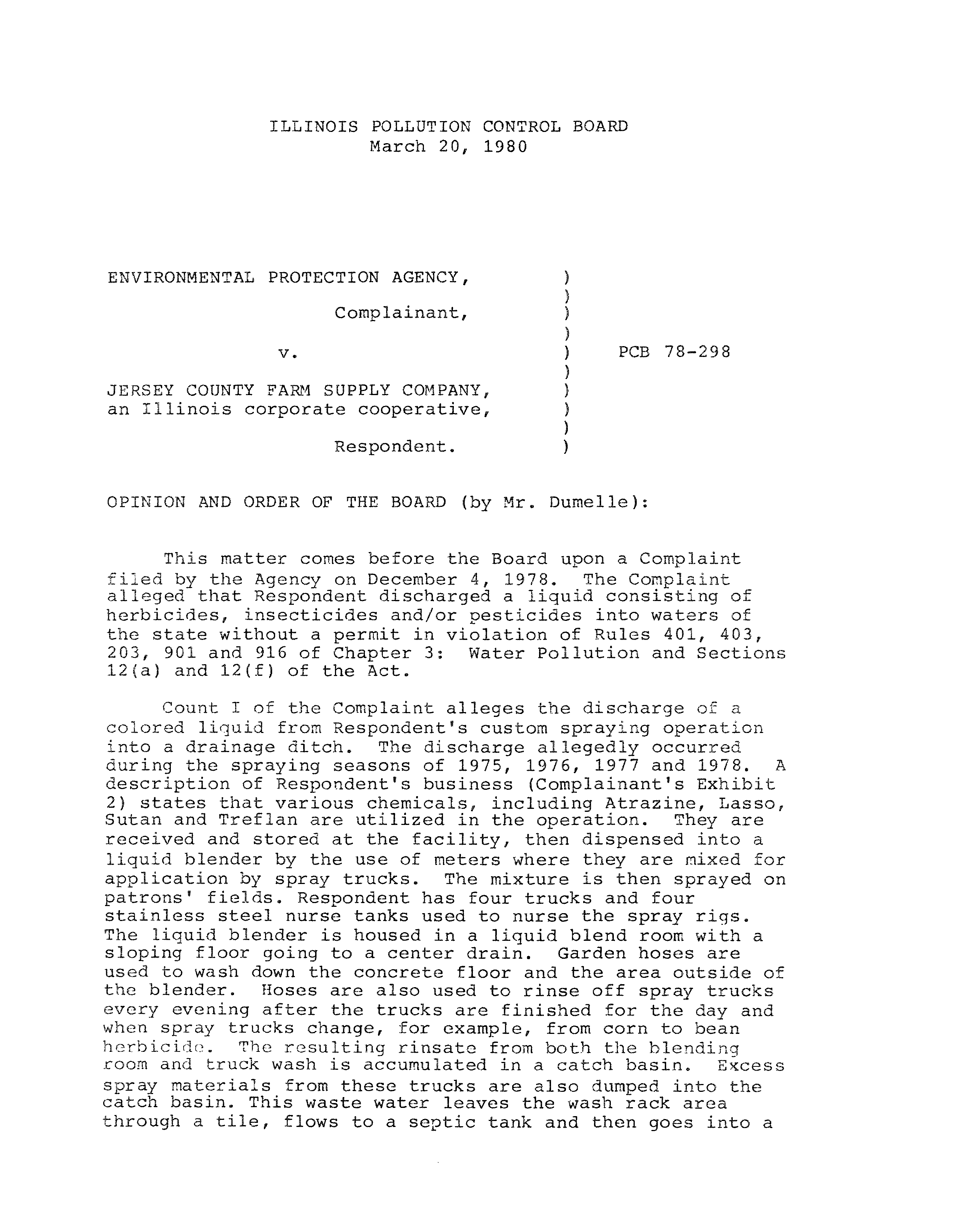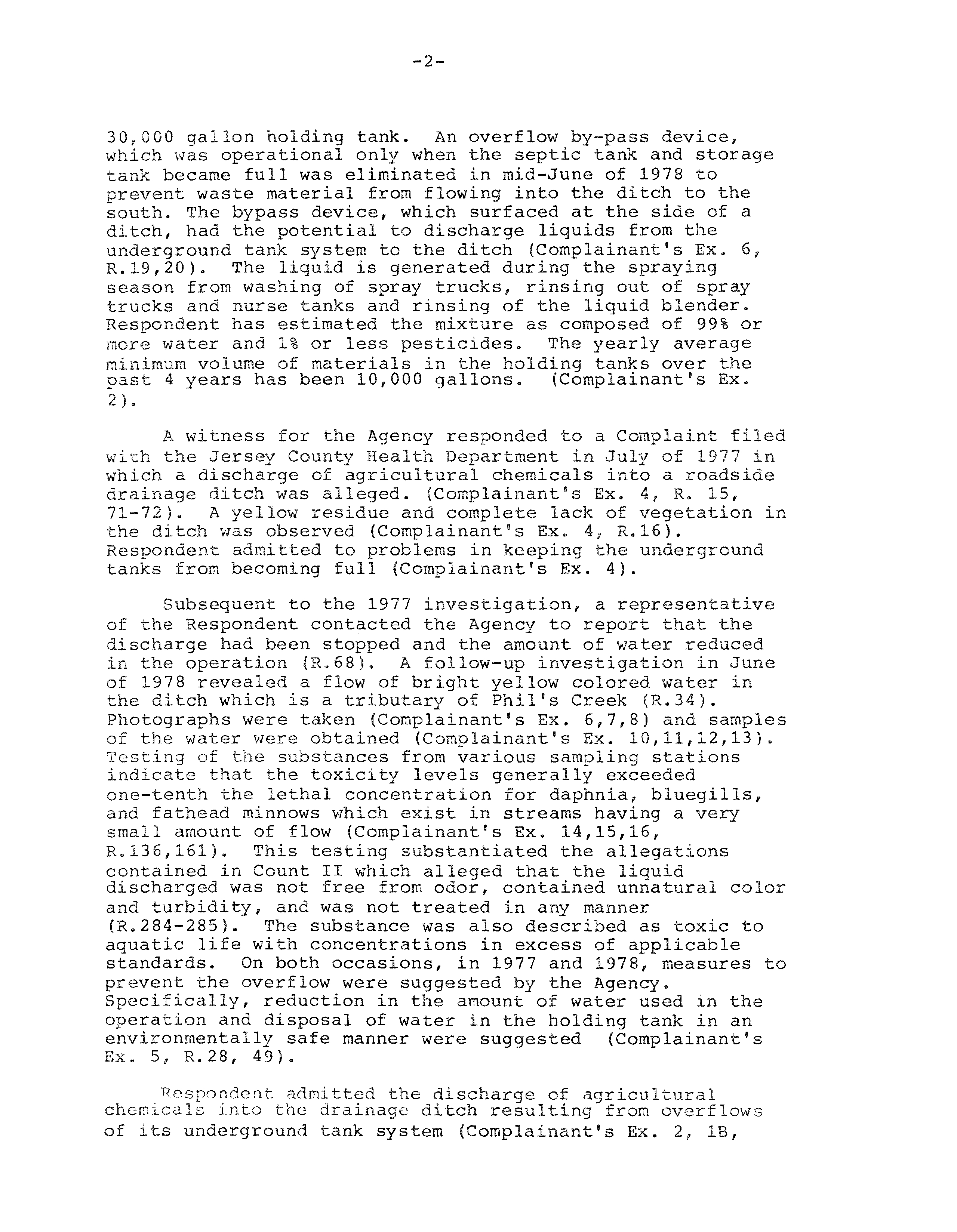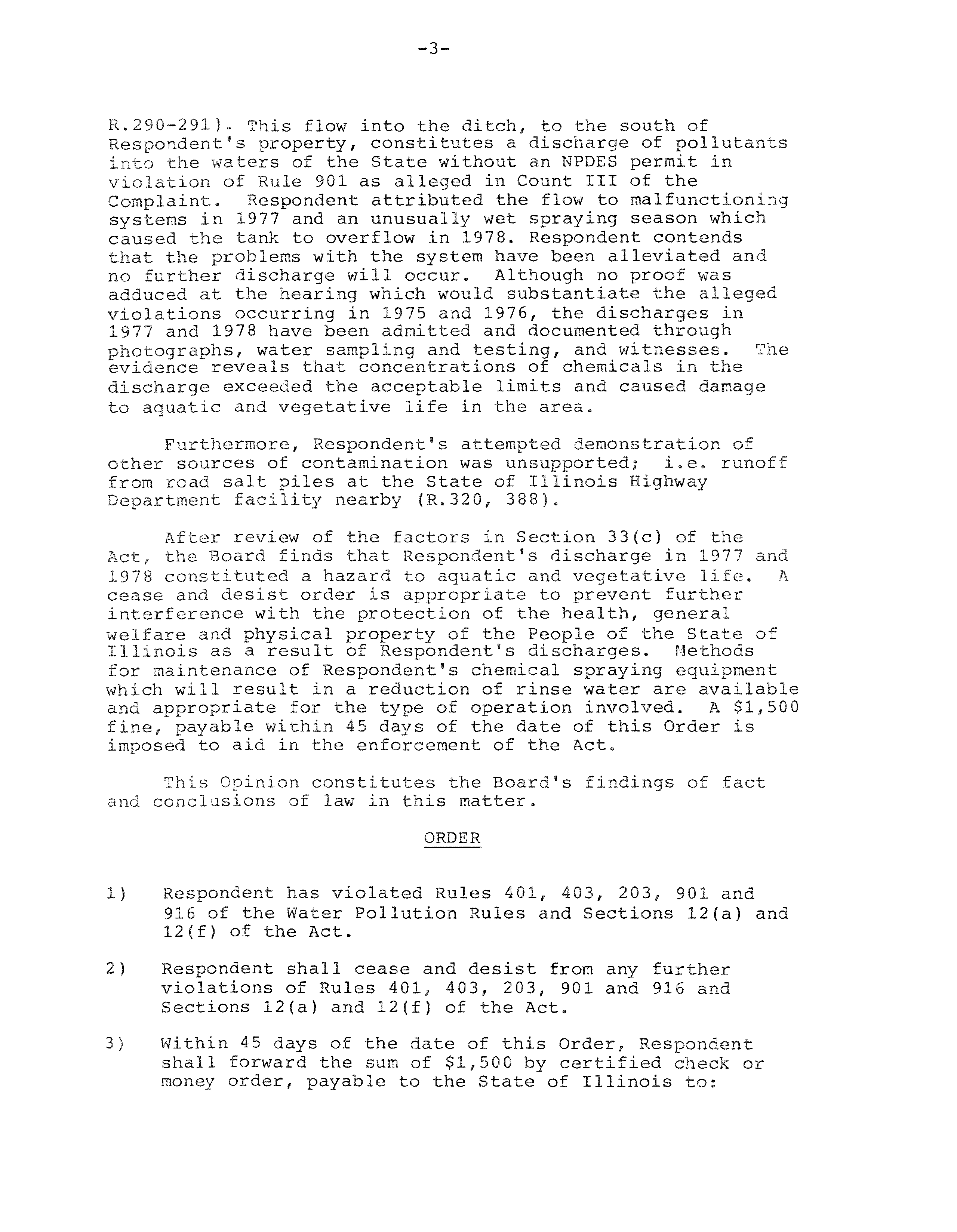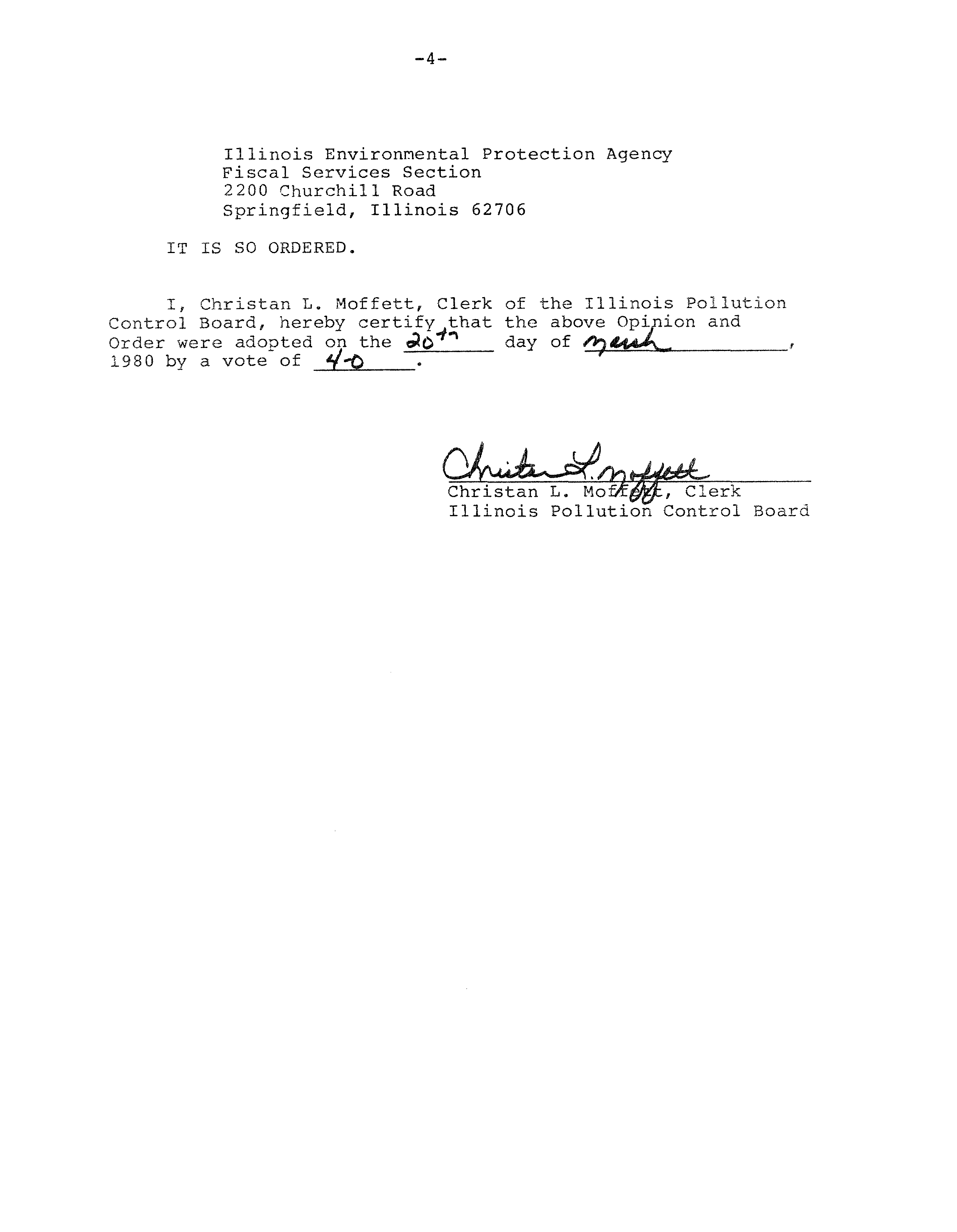ILLINOIS
POLLUTION
CONTROL BOARD
March 20, 1980
ENVIRONMENTAL
PROTECTION
AGENCY,
)
)
Complainant,
)
v.
)
P~B
78—298
)
JERSEY COUNTY
FA1t
SUPPLY
COMPANY,
)
an
Illinois
corporate
cooperative,
)
)
Respondent.
)
OPINION
AND
ORDER
OF
THE
BOARD
(by
Mr.
Dumelle):
This
matter
comes
before
the
Board
upon
a
Complaint
filed
by
the
Agency
on
December
4,
1978.
The
Complaint
alleged that Respondent discharged a liquid consisting of
herbicides, insecticides and/or pesticides into waters of
the state without a permit in violation of Rules 401,
403,
203, 901 and 916 of Chapter 3:
Water Pollution and Sections
12(a) and 12(f) of the Act.
Count I of the Complaint alleges the discharge of a
colored liquid from Respondent’s custom spraying operation
into a drainage ditch.
The discharge allegedly occurred
during the spraying seasons of 1975, 1976,
1977 and 1978.
A
description of Respondent’s business (Complainant’s Exhibit
2) states that various chemicals, including Atrazine, Lasso,
Sutan and Treflan are utilized in the operation.
They are
received and stored at the facility, then dispensed into a
liquid blender by the use of meters where they are mixed for
application by spray trucks.
The mixture is then sprayed on
patrons’ fields. Respondent has four trucks and four
stainless steel nurse tanks used to nurse the spray rigs.
The liquid blender is housed in a liquid blend room with a
sloping floor going to a center drain.
Garden hoses are
used to wash down the concrete floor and the area outside of
the blender.
Hoses are also used to rinse off spray trucks
every evening after the trucks are finished for the
day
and
when spray trucks change,
for example, from corn to bean
herbicide.
The resulting rinsate from both the blending
room and truck wash is accumulated in a catch basin.
E,ccess
spray materials from these trucks are also dumped into the
catch basin. This waste water leaves the wash rack area
through a tile, flows to a septic tank and then goes into a
—2—
30,000 gallon holding tank.
An overflow by—pass device,
which was operational only when the septic tank and
storage
tank became full was eliminated in mid-June of 1978 to
prevent waste material from flowing into the ditch to the
south. The bypass device, which surfaced at the side of a
ditch, had the potential to discharge liquids from the
underground tank system to the ditch
(Complainant’s Hz.
6,
R.19,20).
The
liquid is generated during the spraying
season
from
washing
of
spray
trucks,
rinsing
out
of
spray
trucks and nurse tanks and rinsing of the liquid blender.
Respondent has estimated the mixture as composed of 99
or
more water and 1
or less pesticides.
The yearly average
minimum volume of materials in the holding tanks over the
past
4 years has been 10,000 gallons.
(Complainant’s Ex.
2).
A witness for the Agency responded to a Complaint filed
with the Jersey County Health Department in July of 1977 in
which a discharge of agricultural chemicals into a roadside
drainage ditch was alleged.
(Complainant’s Hz.
4,
R.
15,
71-72).
A yellow residue and complete lack of vegetation in
the ditch was observed (Complainant’s Hz.
4, R.16).
Respondent
admitted
to
problems
in
keeping
the
underground
tanks from becoming full
(Complainant’s Hz.
4).
Subsequent to the 1977 investigation, a representative
of
the
Respondent
contacted
the
Agency
to
report
that
the
discharge
had
been
stopped
and
the
amount
of
water
reduced
in
the
operation
(R.68).
A follow-up investigation in June
of 1978 revealed a flow of bright yellow colored water in
the ditch which is a tributary of Phil’s Creek
(R.34).
Photographs were taken
(Complainant’s Hz. 6,7,8) and samples
of the water were obtained (Complainant’s Hz.
10,11,12,13).
Testing of the substances from various sampling stations
indicate that the toxicity levels generally exceeded
one—tenth the lethal concentration for daphnia, bluegills,
and fathead minnows which exist in streams having a very
small amount of flow
(Complainant’s Hz. 14,15,16,
R.136,161).
This testing substantiated the allegations
contained in Count II which alleged that the liquid
discharged was not free from odor, contained unnatural color
and turbidity, and was not treated in any manner
(R.284—285).
The substance was also described as toxic to
aquatic life with concentrations in excess of applicable
standards.
On both occasions, in 1977 and 1978, measures to
prevent
the
overflow
were
suggested
by
the
Agency.
Specifically,
reduction
in
the
amount of water used in the
operation
and
disposal
of
water
in
the
holding
tank
in
an
environmentally
safe
manner
were
suggested
(Complainant’s
Ex.
5, R.28,
49).
Respondent admitted the discharge of agricultural
chemicals into the drainage ditch resulting from overflows
of its underground tank system (Complainant’s Hz.
2,
18,
—3—
R.290—29i)~
This
flow into the ditch,
to the south of
Respondent~sproperty,
constitutes a discharge
of pollutants
into the waters of
the
State without an NPDES permit in
violation
of Rule 901 as alleged
in Count III
of
the
Complaint.
Respondent attributed the flow to malfunctioning
systems in 1977 and an unusually wet spraying season which
caused the tank to overflow in 1978.
Respondent contends
that the problems with the system have been alleviated and
no
further discharge will occur.
Although no proof was
adduced at the hearing which would substantiate the alleged
violations
occurring
in 1975
and
1976,
the
discharges
in
1977 and 1978 have been admitted and documented through
photographs,
water sampling and testing,
and witnesses,
The
evidence reveals that concentrations of chemicals
in the
discharge exceeded the acceptable limits and caused damage
to aquatic and vegetative
life
in the area.
Furthermore,
Respondent’s attempted demonstration of
other sources
of
contamination was unsupported;
i.e.
runoff
from road salt piles at the State of Illinois Highway
Department
facility nearby
(R,320,
388),
After review
of the factors
in Section 33(c)
of the
Act,
the
Board
finds
that Respondent’s discharge
in 1977 and
1978
constituted
a hazard to aquatic and vegetative
life.
A
cease and desist order is appropriate
to prevent further
interference with the protection
of the health,
general
welfare
and physical property of the People of the State
of
Illinois as a result
of Respondent’s discharges.
Methods
for maintenance of Respondent’s chemical spraying equipment
which will result in a reduction of rinse water are available
and appropriate for the type of operation involved.
A $1,500
fine,
payable within 45 days of the date of this Order
is
imposed to aid
in the enforcement of the Act.
This Opinion constitutes the Board’s findings of
fact
and conclesions of law
in this matter.
ORDER
1)
Respondent
has
violated
Rules
401,
403,
203,
901 and
916 of the Water Pollution Rules and Sections 12(a) and
12(f)
of the Act.
2)
Respondent shall
cease and desist from any further
violations
of Rules
401,
403,
203,
901 and 916 and
Sections 12(a)
and 12(f)
of the Act.
3)
Within
45
days
of
the
date
of this Order, Respondent
shall forward
the
sum of $1,500 by certified check or
money order, payable
to the State
of Illinois
to:
—4—
Illinois Environmental Protection Agency
Fiscal Services Section
2200 Churchill Road
Springfield,
Illinois 62706
IT
IS SO ORDERED.
I, Christan L,
Moffett, Clerk of the Illinois Pollution
Control Board, hereby certify that the above Opi ion and
Order were adopted on the
________
day
of
__________________
1980 by a vote of
~/~0
Christan
L.
~
Clerk
Illinois Pollution Control Board




